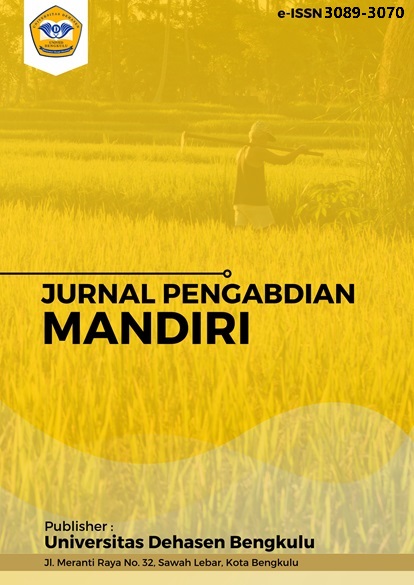Utilization Of Environmentally-Based Cattle Farming Waste For Composting To Increase Community Income In Ngadirejo Village, Tugumulyo Sub-District, Musi Rawas District
DOI:
https://doi.org/10.70963/mandiri.v2i1.768Keywords:
Waste Utilization, Compost, IncomeAbstract
In terms of economy and social, processing cattle waste into compost can create business opportunities for farmers and the surrounding community. This is in line with SDGs point 8, Decent Work and Economic Growth, which encourages job creation and an environmentally-based circular economy. With innovation in livestock waste management, farmers not only reduce negative impacts on the environment but also gain economic benefits from the sale of compost (Sarwono, 2018), in terms of environment, the use of livestock waste for compost production also supports SDGs point 15, Life on Land, which focuses on preserving terrestrial ecosystems. Compost can increase biodiversity in the soil, improve soil structure, and reduce erosion. The method used in this community service activity is a participatory and educational-applicative approach, which prioritizes the active involvement of the target community in all stages of the activity. This approach aims to build community independence in processing cattle waste into compost sustainably. This community service activity has succeeded in showing that cattle waste which was previously a source of pollution can be converted into a product of economic value in the form of organic compost. Through training, mentoring, and the application of simple technology, the people of Ngadirejo Village now have the knowledge and skills to process livestock waste into compost that is useful for the agricultural sector which has the potential for income and provides environmentally friendly livestock education.
References
Indriani, L., and Ramelan, AH 2021. Utilization of Organic Waste into Compost as a Solution for Sustainable Waste Management . Journal of Community Service, 5(2), 101–108.
Indriani, R. 2015. Organic Waste Processing Techniques into Compost . Jakarta: Penebar Swadaya.
Isroi. 2017. Microbiology in Composting . Yogyakarta: Gadjah Mada University Press.
Isroi.2019. Vermicomposting: Environmentally Friendly Technology for Organic Waste Management . Agricultural Research and Development Center.
Rokhyati, UA 2023. Community Empowerment of Cattle Waste as Biogas and Organic Fertilizer in Bube Baru Village, Suwawa District, Bone Bolango Regency. PARADIGMA: Journal of Community Service, 1(1).https://jopa.unwiku.ac.id/index.php/paradigma/article/view/
Sarwono, B. 2018. Sustainable Livestock Waste Processing Technology . Bogor: IPB Press.
Setiawan BD, Nofrida H, Jati PZ, Adlan ZU, Agustina SD 2023. Potential for beef cattle development with location quation analysis in Tugumulyo District, Musi Rawas Regency. Livestock Stock. Vol. 5 (1), 51-57. DOI: https://doi.org/10.36355/sptr.v5i1
Sodiq, A., and Budiono, A. 2012. Analysis of Household Livestock Business Income. Journal of Animal Science, 12(2), 1-10
Suhartini, E. 2020. Utilization of Livestock Waste for Sustainable Agriculture . Bandung: Pustaka Agribisnis.
Suryati, N., & Wahyuni, N. 2022. Farming Business Efficiency Through the Utilization of Livestock Waste for Making Compost Fertilizer. Masda Journal, 1(2), 121–124. https://doi.org/10.58328/jm.v1i2.94
Susilowati, SH, Prabowo, S., & Lestari, DA (2018). Environmental Impacts of Cattle Farming and Its Management Alternatives . Journal of Environmental Science, 16(1), 15–22.
Sutanto, R. (2012). Organic Fertilizer and Biological Fertilizer . Yogyakarta: Kanisius.
Downloads
Published
How to Cite
Issue
Section
License
Copyright (c) 2025 Betty Herlina, Bagus Dimas Setiawan, Syintia Dwi Agustina, Sadjadi Sadjadi, Zulhapi Utama Adlan

This work is licensed under a Creative Commons Attribution-ShareAlike 4.0 International License.





